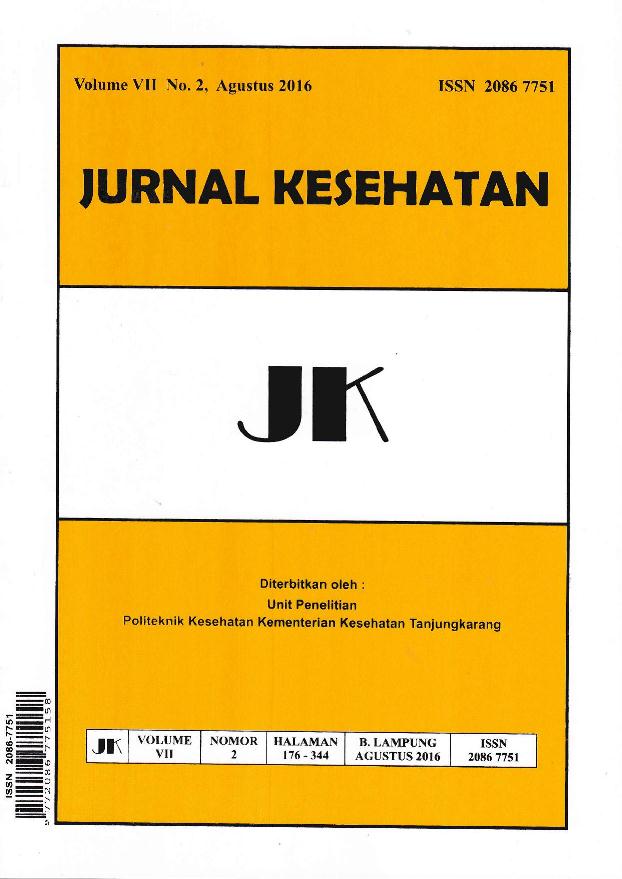Beda Pengaruh Intervensi Peregangan Dan Mobilisasi Sendi terhadap Perbaikan Keterbatasan Lingkup Gerak Sendi
DOI:
https://doi.org/10.26630/jk.v7i2.186Keywords:
Mobilization with movement, End range mobilization, Lingkup gerak sendiAbstract
Keterbatasan sendi adalah hilangnya kemampuan mobilitas aktif dan pasif dari suatu persendian tubuh yang mengakibatkan terganggunya aktivitas kegiatan sehari-hari. Tujuan dilakukan penelitian ini adalah untuk mengetahui perbedaan pengaruh intervensi peregangan sendi dengan teknik end range mobilization dan mobilization with movement terhadap perbaikan keterbatasan lingkup gerak sendi dengan subjek penelitian 20 orang pasien frozen shoulder dengan rentang usia 40-65tahun. Metode penelitian yang digunakan adalah experimental, dengan rancangan two group pre and post test design. Hasil uji beda post test kelompok mobilization with movement diperoleh hasil selisih rerata nilai LGS pre dan post, untuk LGS eksternal rotasi bahu adalah 19,5o, untuk LGS abduksi bahu adalah 31,5o, dan LGS internal rotasi bahu adalah 27o. Sedangkan hasil selisih rerata pada kelompok end range mobilization untuk LGS eksternal rotasi bahu adalah 5,5o, untuk LGS abduksi bahu adalah 11,5o dan untuk LGS internal rotasi bahu adalah 7,5o. Maka dapat disimpulkan intervensi teknik mobilization with movement lebih berpengaruh dibandingkan teknik peregangan dengan end range mobilization terhadap perbaikan keterbatasan lingkup gerak sendi.
References
Chen, Judy. 2012. Effectiveness of Passive Joint Mobilization for Shoulder Dysfunction: A Review of The Literature. Physiotherapy Department The Prince of Wales Hospital Sydney. 21st- Century. ISBN: 978-953-51- 0459 9.
Donatelli, R. 1997. Physical Therapy of the Shoulder. Third Edition, Churchill Livingston, United States of America.
Goyal, M. 2013. Combined Effect of End Range mobilization (ERM) and Mobilization with Movement (MWM) Techniques on Range Of Motion and Disability in Frozen Shoulder Patients: A Randomized Clinical Trial; Journal of Exercise Science and Physiotherapy. Journal of Exercise and Phsiotherapy. Vol. 9 No. 2, 74-82.
Hayes, K., Walton, J., Szomor, Z., Murrell, G. 2001. Reliability of five methods for assessing shoulder range of motion. Australian Journal of Physiotherapy. Volume 47. Number 289-294.
Hinton, Jame, 2013. The Effectiveness of end-Range joint Mobilization For Patients With Adhesive Capsulitis. UCSF/SFSU Graduate Program in Physical Therapy. PT 209 910.
Kapandji, I. A. 1989. The Physiology of the Joitns. Fifth Edition. Churchill Livingstone.
Kachingwe, A, F. 2008. Comparison of Manual Therapy Techniques with Therapeutic Exercise in the Treatment of Shoulder Impingement: A Randomized Controlled Pilot Clinical Trial. The Journal Of Manual & Manipulative Therapy. Volume 16 Number 4.
Kazmi, M., Devi, J., Yamin, Kumar. 2013. Comparative Study on the Efficacy of Maitland Technique (Grade IV) and Mulligan Technique, in the Treatment of Frozen Shoulder. Pakistan Journal of Rehabilitation. Volume 2. Issue 1.
Kelley, Martin, J. 2009. Frozen Shoulder; Evidence and a Proposed Model Guiding Rehabilitation. Journal of Orthopaedic and Sports Physical Therapy. Volume 39: Number 2.
Kisner, C., Colby, L. A. 2012. Therapeutic Exercise Foundation and Technique. Sixth Edition, F. A. Davis Company, Philadelphia.
Kumar, A., Aggarwal, A., Kumar, R., Ghosh Das, P. 2012. Effectiveness of Maitland Techniques in Idiopathic Shoulder Adhesive Capsulitis. International Scholarly Research Network Rehabilitation, Volume 2012, page. 8.
Maitland, G., D. 199. Peripheral Maipulation. Third Edition, Butterworth & Co Publishers, London.
Neviaser, A, S. 2010. Adhesive Capsulitis: A Review of Current Treatment. The American Journal of Sport medicine. First Version 38: 2346.
Page, P., Labbe, A. Adhesive Capsulitis: Use The Evidence to Integrate Interventions. North American Journal of Sport Physical therapy. V. 5(4), 266-273.
Russe, O. A., Gerhardt, J. J. 1975. International STFR Method of Measuring and Recording Joint Motion. Hans Huber Publishers Bern Stuttgart Vienna.
Schomacher, Jochen. 2014. Orthopedic Manual Therapy. Thieme Publisher Stuttgart. New York.
Teys, P. 2006. The Initial Effect of a Mulligan’s Mobilization with Movement technique on Range Of Movement and Pressure Pain Threshold in Pain-Limited Shoulders. Science Direct. Volume: 13, 37-42.
Threlkel, Joseph. 1992. The Effects of manual Therapy on Connective Tissue. Physical Therapy Journal: APTA. Volume 72, number 12:893-902.
Vermeulen, H, M. 2000. End-Range Mobilization Techniques in Adhesive Capsulitis of the Shoulder Joint: A Multiple-Subject Case Report. Journal of the American Physical Therapy Association and de Fysiotherapeut. Volume 80:1204-1213.
Yang, J. 2007. Mobilization Techniques in Subjects With Frozen Shoulder Syndrome: Randomized Multiple- Treatment Trial. American Physical Therapy Association, Volume 87 Number 10 Physical Therapy f 1307.
Downloads
Published
Issue
Section
License
Authors who publish in this journal agree to the following terms:
- Authors retain copyright and grant the journal right of first publication with the work simultaneously licensed under a Creative Commons Attribution License (CC BY-SA 4.0) that allows others to share the work with an acknowledgment of the work's authorship and initial publication in this journal.
- Authors can enter into separate, additional contractual arrangements for the non-exclusive distribution of the journal's published version of the work (e.g., post it to an institutional repository or publish it in a book), with an acknowledgment of its initial publication in this journal.
- Authors are permitted and encouraged to post their work online (e.g., in institutional repositories or on their website) prior to and during the submission process, as this can lead to productive exchanges and earlier and greater citations of published work.












